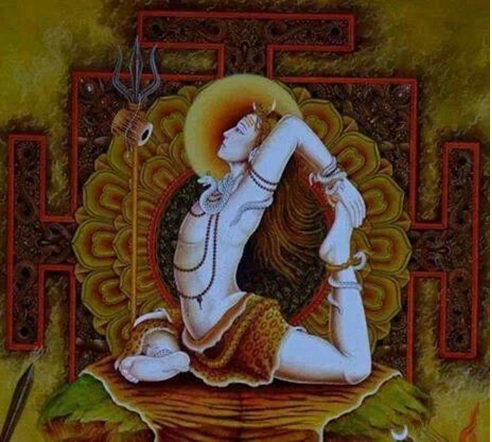
After my last spiritual retreat called Sadashivoham 2016 in last December, I find that this year I am slowly gravitating towards the very source of Yoga from Veda-Agamas which is the Source books of Hinduism or Sanatana Hindu Dharma. The revelation from the Veda-Agamas form the Shastra Pramana – the scriptural authority on truth which came down directly from the mouth of Adi Yogi (original Yogi) – Sadashiva to his consort, Devi Adishakti.
For a living Yogi, I am so grateful to my Guru, Paramahamsa Nithyananda (fondly known as Swamiji) who is a living incarnation, for reviving the original space of Yoga from which Sadashiva created this science. He reveals that “Vedas are the ultimate, superior authority for the Hindus. Vedas are like a pure science where the ultimate truths are explained whereas Agamas are the scriptures where the applied technology, the applied science is expounded.”
Agamas are directly revealed by Sadashiva include the various systems such as
1) Jnana Pada or Vidya Pada – the knowledge
2) Kriya Pada – the rituals
3) Yoga Pada – the Yoga knowledge and science
4) Carya Pada – the enlightened lifestyle
He further reveals that Nithyananda Yoga combines the 3 pramanas, namely Shastra Pramana which is from Veda-Agamas, Apta Pramana is from experiences of enlightened sages like Rishis, Munis, and Avatars & finally the Atma Pramana is from Swamiji’s very direct experiences. When these 3 are combined does the initiation safely culminate in Sakshi Pramana – the individual disciple’s experience of the highest state and power manifestations of Yoga. After years of dilution and pollution of this sacred science, the most profound and context of Yoga is now being revived and transmitted as a tangible experience by Swamiji.
I am going to share a few important Shastra pramanas from the Source which resonated within me, they lead me into a new space of knowledge in Yoga:
- Treatise on Yoga – “I will explain the disciplines of Yoga as applicable to the one who is alone keeping himself dissociated from the company of worldly-minded persons, who is with settled mind, who is with deep sense of detachment by keeping his mind under control, who takes moderate food, who limits himself in his routine worldly activities and who sleeps moderately and keeps himself awake sufficiently. Listen to my instructions on Yoga. The term eka’kinah denotes an ascetic who has his mind completely detached from the worldly activities. Santah means one who is not harmful, who is with composed and calm mind. Viraginah denotes a person who has controlled his mind and senses, on whom Sadashiva’s Grace has descended and as a result who is deeply intent in the attainment of Sadashivatva (state of oneness with Sadashiva). Yatachitta means the mind which remains effortlessly settled through breath control and withdrawal of senses.”
- Knowledge of person qualified for Yoga – “Only that person who has known well the nature of meditator, meditation and the fruit of meditation is fit enough to undertake the disciplines of Yoga. The individual self is the meditator, mind is the meditation and the great Lord Shiva is the One to be meditated. The attainment of the supreme qualities of Shiva, superior to which there is nothing, is the fruit of meditation.”
- State of mind for the continuous practice of Yoga – “Keeping the mind balanced well when honoured or abused, and in the same way when delighted or distressed and having completely freed himself from being subject to excessive delight, fearfulness and despondency, the sadhaka (aspirant) should repeatedly practice the disciplines of Yoga.”
- Description of posture and state of mind to start the practice of Yoga – “Having assumed a posture compatible to him and folding the hands together to express supplication and keeping his body upright, having well aligned his head and having abandoned all the negative thoughts from his mind. O Guha! The sadhaka should practice yoga with his mind well-established within his own self.”
- Shiva Mulamantra as instructed by Guru before commencing Yoga – “Without allowing the upper row of teeth to touch the lower teeth and without allowing the tongue to touch the corners of the mouth, and keeping his eyes half closed and raised, the sadhaka should repeat the mulamantra of Shiva in a perfect way as instructed by his Guru. The systematic repetition of mulamantra illuminates and makes known all the tattvas such as the subtle elements (tanmatras) and others to the embodied self. O San.Mukha!, the sadhaka then becomes capable of severing his bonds born of these tattvas (spiritual principles) through the particular repetition of astra mantra instructed to him by his Guru.”
- Equalizing Prana and meditation on Shiva – “Having equalized the outbreath and inbreath (prana and apana) and having enabled the breath to flow through within the central channel (susumna) and having arrested the workings of inbreath and outbreath, the well skilled sadhaka should deeply meditate on Lord Shiva.”
- Achieving union with Shiva through such practice – “Through the continued practice of such discipline, the sadhaka becomes capable of establishing himself in unfailing and inseparable union with the luminous for which is extremely subtle, pervasive, eternal and immutable.”
The more I become aware of the original instructions by Sadashiva, the more I am able to experience the space of Yoga with Sadashiva. In fact, this morning I had a brand new experience on the one to be meditated. From my experience, each Shastra Pramana actually opens up a whole new experience and understanding in me. If you are a sincere yoga practitioner, I highly recommend you start imbibing these fundamental Shastra pramanas so that they become your own experiences – Shaksi pramana. Namaste! 😀
Note – link to the Nithyananda Yoga https://www.facebook.com/THEoriginalYoga/